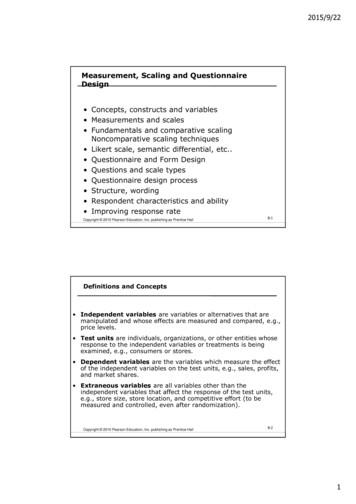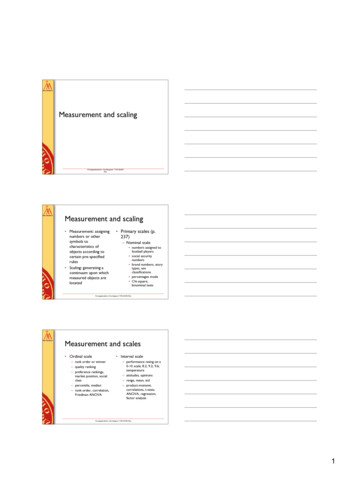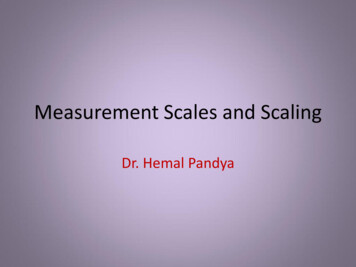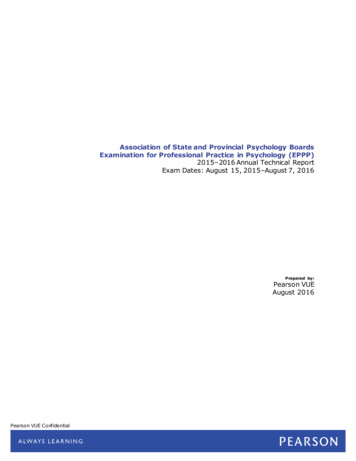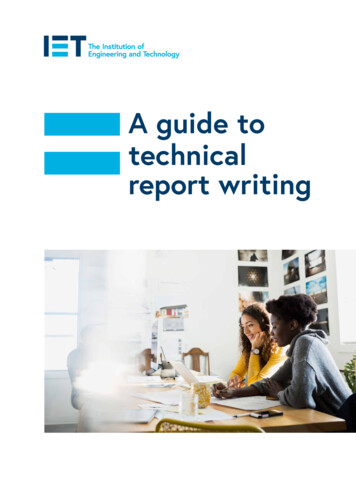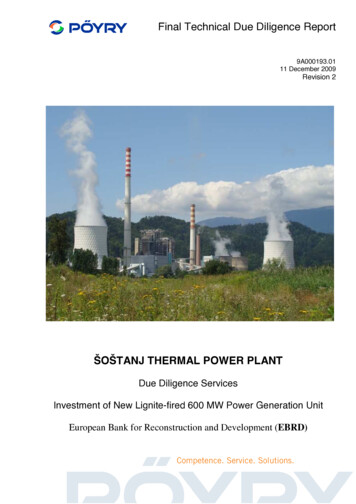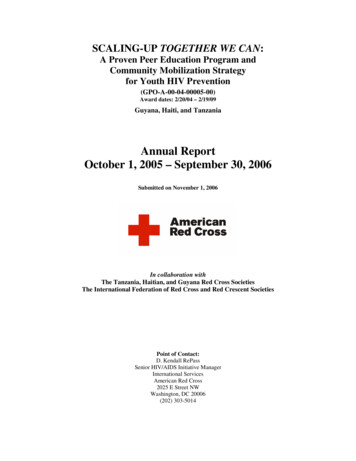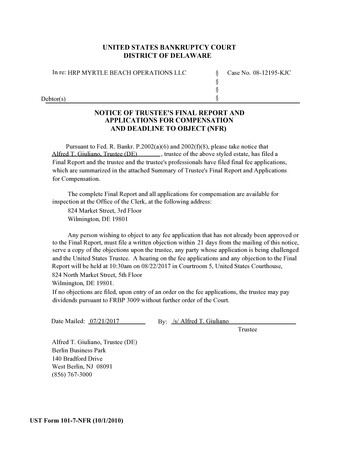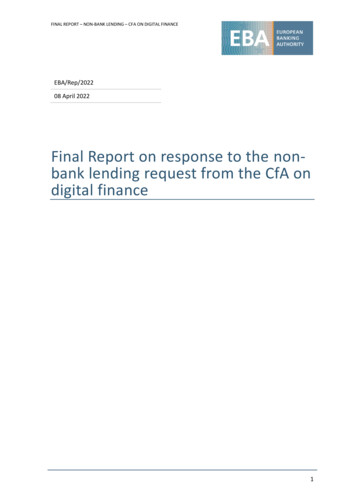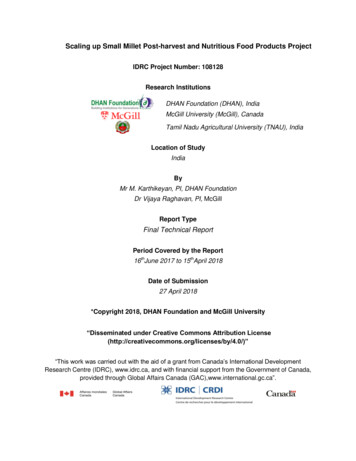
Transcription
Scaling up Small Millet Post-harvest and Nutritious Food Products ProjectIDRC Project Number: 108128Research InstitutionsDHAN Foundation (DHAN), IndiaMcGill University (McGill), CanadaTamil Nadu Agricultural University (TNAU), IndiaLocation of StudyIndiaByMr M. Karthikeyan, PI, DHAN FoundationDr Vijaya Raghavan, PI, McGillReport TypeFinal Technical ReportPeriod Covered by the Report16thJune 2017 to 15thApril 2018Date of Submission27 April 2018*Copyright 2018, DHAN Foundation and McGill University“Disseminated under Creative Commons Attribution /)”―This work was carried out with the aid of a grant from Canada‘s International DevelopmentResearch Centre (IDRC), www.idrc.ca, and with financial support from the Government of Canada,provided through Global Affairs Canada (GAC),www.international.gc.ca‖.
Final Technical Report, Scaling up Small Millet Post-harvest & Nutritious Food Products Project2018ContentsAcronyms . iv1.Executive summary. 12.The research problem . 13.Progress towards milestones . 54.Synthesis of research results and development outcomes .215.Project outputs .666.Problems and Challenges .717.Administrative Reflections and Recommendations.73References .74AnnexesAnnex 1Template for AFS research output title and abstract pageGiven as attachmentAnnex 2.1Potential market for small millet processing units of different scale in IndiaAnnex 2.2Implementation of mechanized post-harvest processingtechnologies for millets: A reviewAnnex 2.3Millet Usage & Attitude Study: Research findings on a Usage & Attitude studyacross Urban as well as Rural areas of India, 2017Annex 2.4Studies to assess the health benefits of selected small millet productsAnnex 2.5Nutritional Comparison of Millets with other SuperfoodsAnnex 2.6Capacity building on small millet processing across IndiaAnnex 2.7Top communication outputs from projectAnnex 2.8Helping Agribusinesses—Small Millets Value Chain—To Grow in IndiaAnnex 2.9Details of support offered to micro, small and medium millet food enterprisesin Tamil NaduAnnex 2.10Details of new products developed by food enterprisesAnnex 2.11A photo essay on interventions to support Pushcart Millet Porridge Vendors,Tamil NaduAnnex 2.12Research initiatives for addressing the technology gaps in primary processing ofsmall milletsAnnex 2.13Development of a millet dehuller (hand – operated) to reduce drudgery inprocessing and utilization of Millet waste (hulls) in antioxidant extractionDHAN Foundation & McGill UniversityPage i
Final Technical Report, Scaling up Small Millet Post-harvest & Nutritious Food Products Project2018Annex 2.14Comprehensive support package for MSMEs in millet sector - A policy studyAnnex 2.15List of Collaborating OrganizationsAnnex 2.16A note on promotion of small millet through Voice SMS CampaignList of TablesTable 1: Reach of small millet processing equipment across the countryTable 2: Details of capacity building events on preparation of small millet value-added foodproductsTable 3: Data on critical parameters related to processing of small milletsTable 4: Performance of Otake huller for processing small milletsTable 5: Comparison of nutrient content of little millet rice obtained by different processingMethodsList of FiguresFigure 1: Improved impact hullers for processing small millets developed in the projectFigure 2: Short films on cooking demos of small millet recipes in HindiFigure 3: Bioavailability studies of small millet recipesFigure 4: National policy workshop on Mainstreaming Small Millets in Our Diets, New Delhi.Figure 5: Training on small millet processing at Dantewada, ChhattisgarhFigure 6: New small millet-based food products introduced by food enterprisesFigure 7: Walkathon 2016, Krishnagiri, Tamil NaduFigure 8: Assessment of the novel small millet recipes by the juryFigure 9: On-site incubation model attempted with equipment manufacturersFigure 10: Improvement of existing processing equipment by VICTOR AGRO SALESFigure 11: Support given for revival of small millet processing unitsFigure 12: On-site incubation support for small millet food enterprises attempted in the projectFigure 13: Small millet puffsFigure 14: New millet outlet initiated by Atchaya Foods at Madurai, Tamil NaduFigure 15: WhatsApp group on small millet marketingFigure 16: Training session on Recipe demonstration at Raipur, ChhattisgarhFigure 17: Assessment of centrifugal dehullerFigure 18: Trials with Otake rice huller at earth360 Eco Ventures Pvt. Ltd.Figure 19: Pneumatic grain cleanerFigure 20: Hand operated rubber roller type hullerFigure 21: Food enterprises supported for participation in Organics & Millets 2018, BengaluruDHAN Foundation & McGill UniversityPage ii
Final Technical Report, Scaling up Small Millet Post-harvest & Nutritious Food Products Project2018Figure 22: Small millet processing unit set up by Peraiyur FPOFigure 23: Participants of Project Dissemination WorkshopFigure 24: Interaction with small-scale equipment manufacturer in ZimbabweFigure 25: Training of local cadre of mechanics by VICTOR AGRO SALES, Salem, Tamil NaduFigure 26: Short films on modern value added small millet-based food productsFigure 27: Approach followed for promoting consumption of small milletsFigure 28: School awareness event in progress at Krishnagiri, Tamil NaduFigure 29: Facebook group on MilletsFigure 30: Distribution of small millet rice by women federations at SalemFigure 31: Transformation of local and regional value chains in Tamil Nadu regionFigure 32: Recipe demonstration in progress in ChittoorFigure 33: Women friendly design of small millet processing equipmentDHAN Foundation & McGill UniversityPage iii
Final Technical Report, Scaling up Small Millet Post-harvest & Nutritious Food Products Project2018AcronymsCFTRICIFSRFCentral Food Technological Research InstituteCanadian International Food Security Research FundCRSCommunity Radio StationCSMPDHANCommunity Scale Small Millet ProcessingDevelopment of Humane Action FoundationFACHIGFPOFarmers' Association of Community self-Help Investment GroupsFarmers Producer OrganisationFSSAIGACFood Safety and Standards Authority of IndiaGlobal Affairs CanadaGIZGesellschaft für Internationale ZusammenarbeitGSTICARGoods and Services TaxIndian Council of Agricultural ResearchICCOAIDRCInternational Competence Centre for Organic AgricultureInternational Development Research CentreIFADIFPRIInternational Fund for Agricultural DevelopmentInternational Food Policy Research InstituteIGKVIndira Gandhi Krishi VishwavidyalayaIIMRKVKIndian Institute of Millets ResearchKrishi Vigyan KendraMAVIMMcGillMahila Arthik Vikas MahamandalMcGill UniversityMoUMSMEsMemorandum of UnderstandingMicro, Small and Medium EnterprisesMSPMinimum Support PriceMSSRFNABARDM S Swaminathan Research FoundationNational Bank for Agriculture and Rural DevelopmentNGONSICNon-government organizationNational Small Industries CorporationPDSPIPublic Distribution SystemPrincipal InvestigatorPMPVPushcart Millet Porridge VendorR&DRESMISAResearch and DevelopmentRevalorising Small Millets in Rainfed Regions of South AsiaSHGSMEsSelf Help GroupSmall and Medium EnterprisesSMPUSmall Millet Processing UnitTNAUToTTamil Nadu Agricultural UniversityTraining of TrainersDHAN Foundation & McGill UniversityPage iv
Final Technical Report, Scaling up Small Millet Post-harvest & Nutritious Food Products Project20181. Executive summaryAn action research project titled ―Scaling up Small Millet Post-harvest and Nutritious Food Products‖ wasimplemented by DHAN Foundation, India and McGill University, Canada, along with Tamil NaduAgricultural University, India between December 2015 to April 2018. Its main objective is to develop andapply ways for scaling up small millet processing and value addition technologies to reduce drudgery ofwomen and improve the nutritional (and diet-related health) security in India. This project builds upon theresults of two previous CIFSRF projects viz. i) Revalorizing Small Millets in Rainfed Regions of SouthAsia, 2011-2014 and ii) Strengthening of Rural Families Through Empowerment by Introducing FoodSecurity Through Production, Processing and Value Addition of Regional Staple Food Grains, 2010-2012.The project has taken initiatives to scale up two innovations namely (i) appropriate scale small milletprocessing machines and (ii) appealing small millet food products.For scaling up processing technologies, a ‗commercialization business model‘ referred to as ‗on-sitebusiness incubation‘ of equipment manufacturers, and a ‗knowledge transfer business model‘ to revivethe defunct processing units were explored. Six equipment manufacturers were supported for productimprovement, business development and improving visibility. Their products were promoted in Centraland Northern India and at national and international fairs. AVM and Victor improved their product designsand started supplying a huller model with a capacity of 500 kg/hr to meet the requirement of mediumscale enterprises. AVM and Perfura took part in government bidding and secured the work order. Perfuraand Agromech started offering small millet centrifugal huller as part of their product portfolio. Allmanufacturers widened their contact base and reach. Since the start of the project, 173 processing unitshave been supplied for the processing of small millets in 54 districts in 10 States. Nineteen processingunits were revived in Tamil Nadu and Odisha. Of the target of 200 processing units, 192 were reachedand about 1015 tonnes of millet rice and grits have been produced, reaching 288,500 consumers across10 states.For scaling up appealing small millet food products, the project explored a ‗commercialization businessmodel‘, which included ‗on-site business incubation‘ of micro, small and medium enterprises (MSMEs)and customised capacity building of cottage enterprises and FPOs. A ‗knowledge transfer businessmodel‘ was explored for scaling up the reach of ‗method/recipes‘, mainly through individuals, consumerorganisations and food service providers. Customised on-site incubation support was offered to 66 micro,small and medium sized food enterprises in Tamil Nadu for scaling up of their operations. Benefiting fromthe project support, the food enterprises in Tamil Nadu were improved in the following aspects:(i) standardisation of foods products (22), (ii) introduction of new products (28), (iii) improvement inpackaging (21), (iv) improvement in hygienic practices (35), (v) improvement in production capacity (14),(vi) increased visibility (42) and (vii) increase in marketing links (28). Furthermore, the sales volume of 30enterprises increased by more than 15% and, in in addition to their existing markets, their geographicalreach increased to nearby districts and states. Furthermore, twenty-seven entrepreneurs startedcommercialising small millet food products. Support was given to Pushcart Millet Porridge Vendors(PMPVs) in Tamil Nadu, an existing channel serving nutritious millet foods to the low-income sector of thepopulation. As a result, 152 PMPVs have adopted customised food hygiene practices, 76 have registeredwith FSSAI, 75 got biometric card and most of them have improved their image through display of a nameboard, oaths and do‘s and don‘ts of hygienic food handling. Focused efforts were taken for disseminationof small-millet-value-addition technologies to Eastern, Central and Northern India by orienting andbuilding the capacity of 391 potential adopters and promoters such as NGOs and government entities. Asa result, 26 cottage enterprises, two micro enterprises and 14 NGOs have begun production andmarketing of small-millet-based food products. Since the beginning of the project, 210 tonnes of valueadded products have been produced, thereby reaching 278,000 additional consumers.DHAN Foundation & McGill UniversityPage 1
Final Technical Report, Scaling up Small Millet Post-harvest & Nutritious Food Products Project2018Considerable progress was made through need based research related to scaling up small milletprocessing and value addition technologies on: (i) market research in India, (ii) development of the hullingand processing assemblies to meet varying operating requirements at the village, micro enterprise andSME levels, (iii) studies on health benefits of small millet foods, and (iv) working models on scaling up.The initiatives to address technology gaps in primary processing of small millets resulted in (i) generationof valuable data on grain parameters; (ii) improvement of existing processing equipment in terms ofperformance, ease of use and safety; (iii) development of additional equipment: (a) an improved modelcentrifugal huller with higher performance and energy efficiency, (b) a household scale and an enterprisescale rubber-roller type hullers, (c) a pneumatic cleaner, and (d) a vibro-grader; and (iv) identification ofstorage methods for enhancing shelf life of hulled grains and flour. Studies on (i) nutritional comparison ofmillets with other super foods, and (ii) anti-diabetic and bioavailability studies of small-millet-based foodproducts, were taken up to position small millets as a health food category. Lessons learnt fromimplementing scaling up business models were synthesised into (i) on-site incubation model forsupporting equipment manufacturers, (ii) working model to facilitate adoption of processing technology,(iii) on-site incubation model for supporting MSMEs and cottage enterprises, and (iv) working model forpromoting consumption of small millets.The learning acquired from the project activities for scaling up was synthesised into three policydocuments, seven academic papers covering overarching findings of the project, 26 papers on specificresearch results, one output on gender, six video/ audio/ slide shows, four protocols/ guidelines, fourtechnical bulletins, and three study reports. These outputs were widely shared through a nationalseminar, a national policy workshop, and a ―Project Dissemination Workshop‖ and through participation in10 national and international conferences. The project contributed to policy discussion on mainstreamingsmall millets in the regular diets by bringing to attention the policy support needed for developing localand regional value chains, particularly for (i) establishing decentralised processing infrastructure,(ii) establishment of MSMEs and cottage industries in the millet sector, and (iii) addressing supply chainconstraints. The document on strategic directions and specific policy action points for (a) scaling upproduction, (b) processing infrastructure development, (c) market development, and (d) increasinghousehold consumption was shared with the Ministry of Agriculture and Farmers Welfare, Delhi, to feed into the ―Millets Mission‖ being contemplated by the central government and some state governments.Furthermore, a suggestion was made for having a ―sub-mission focusing on small millets‖ within thebroader ―Millets Mission‖. A short note on ―Sub-Mission on Promoting Small Millets in Tamil Nadu underMission on Sustainable Dryland Agriculture‖ was submitted to the Agriculture Production Commissioner inTamil Nadu. The project team participated in a consultation meeting of the ―Comprehensive Revival ofMillets Project‖, Andhra Pradesh and ―Special Programme for Promotion of Millets in Tribal Areas inOdisha‖, to help choose appropriate processing equipment, and given advice on sound procurement andinstallation procedures. On invitation by the government of Tamil Nadu, technical inputs were given onmodalities of inclusion of small millets in the existing public food programs. A detailed document wasshared with NABARD, the national level body that is managing climate adaptation fund, on promotingmillet-based cropping systems as a climate change adaptation strategy. A skill exchange program onsmall millet processing and value addition was organised between FACHIG Trust, Zimbabwe and DHANwith the support of the Agricultural Biodiversity Community.For facilitating adoption of small millet processing equipment, demonstrations of processing equipmentwere organised in 20 locations in Odisha, Tamil Nadu and Andhra Pradesh, Uttarakhand, Telangana,Maharashtra, Madhya Pradesh, and Rajasthan with the support of partner NGOs (14) and Indian Instituteof Millet Research. Demonstrations were also organised at 10 national and international exhibitions andevents. The capacities of 33 village level processors, 25 small scale processors, three medium scaleprocessors, seven FPOs, three food companies, 198 prospective buyers and 62 promoters were built upDHAN Foundation & McGill UniversityPage 2
Final Technical Report, Scaling up Small Millet Post-harvest & Nutritious Food Products Project2018on processing of small millets in Southern, Eastern and Central India. Through these efforts, a soundbeginning for the development of decentralised small millet processing infrastructure was created inEastern and Central India. Awareness posters, a monthly calendar with message on millets, a musicalbum, radio programs, and short films on cooking demos of small millet traditional recipes and modernvalue-added small-millet-based food products were developed and shared widely through the DHANwebsite, YouTube and by sales. In Tamil Nadu, Andhra Pradesh, Karnataka, New Delhi, Odisha,Chhattisgarh, and Kerala, 72,490 persons, mainly women, farmers, and school children, were educatedabout the health benefits of small millets through 84 local and district level promotional events and 21international, national, provincial and local exhibitions. Youths were reached through a novel recipecompetition organised for Catering, Hotel Management and Home Science students and through a shortfilm contest on the theme of ‗Small Millets- Our Food: Our Pride‘. Furthermore, the message of smallmillets reached more than 200,000 persons through programs aired on community radio stations,telecasted on local television channels and by SMS audio messages. The capacity of 829 personsincluding 725 women and 104 men working in 85 women/farmer federations (29 urban and 49 rural and 7tribal) in Tamil Nadu, Andhra Pradesh and Odisha was built on organising recipe demonstrations for endusers. The knowledge and skills of 15,838 persons (12,993 women, 1,719 men and 1,126 children) oninclusion of small millets in their diets were built through recipe demonstration in 334 habitations. About300 tonnes of small millet rice was supplied by different FPOs and by Kalanjiam Thozhilagam Limited,most of which was supplied to members of women/ farmers organisations who fall in the lower middleclass and low-income categories, at a price far lower than the market price. Through these efforts, theattempt to transform small-millet-based food products from the ‗elite food‘ category towards the ‗massfood‘ category was achieved to an extent.The development of appropriate small millet technologies and scaling up of their adoption bystrengthening existing value chain actors and facilitating entry of new actors with the support of twoCIFSRF projects since 2011, played an instrumental role in the transformation of local and regional valuechains in the Tamil Nadu region. These developments have provided valuable expertise and knowledgefor other regions that produce millets. The project resulted in processing equipment with women friendlydesign that reduce women‘s drudgery in processing operations. It also resulted in additional income andemployment for women in many small millet processing units and 191 food enterprises and capacitybuilding of 72 women organisations. The project also provided training for five Masters and PhD studentson development of processing equipment for small millets and of millet based products.The work completed so far by the project partners has contributed to a body of knowledge/technologies/practice, and working models on scaling up small millet processing and value additiontechnologies and set direction for mainstreaming small millets in regular diets in India and in othercountries and regions. Broadly, the project has thrown light on (i) what scaling up approaches work forneglected and underutilized nutritious plant species such as small millets for improving nutrition securityof the masses, and (ii) how markets can be made to adapt for ensuring nutrition security of the masses.There is considerable need and scope for scaling up the learning from the project in India, particularly inCentral and Northern India and in other South Asian and African countries with millets.2. The research problemMany developing countries are facing the triple burden of undernourishment, micronutrient deficiency,and obesity. In India, there is large-scale prevalence of stunted growth among children, and anaemiaamong pregnant women (IFPRI, 2015). Obesity is also fast increasing across rural and urban areas(Kalra et al. 2012). Furthermore, chronic and non-communicable diseases are on the rise. For example,the prevalence of Type-II diabetes mellitus and impaired glucose tolerance were affecting, at an alarmingDHAN Foundation & McGill UniversityPage 3
Final Technical Report, Scaling up Small Millet Post-harvest & Nutritious Food Products Project2018rate, both rural (2.4%) and urban (11.6%) populations (Mohan et al. 2009). Increasing research andepidemiological evidence links the lack of dietary diversity to these health issues (Khoury et al. 2014).Small millets which include finger millet, kodo millet, little millet, foxtail millet, proso millet, and barnyardmillet, are one of the important traditional food groups that have been moved out of the food basket inrecent times (Ramachandran, 2007). Small millets offer better nutrition with various micronutrients likevitamin B complex, calcium, iron and sulphur, high dietary fibre and low glycemic index when comparedto mainstream cereals like rice and wheat (Saleh et al. 2013). They are known as both preventive andcurative foods. Small millet crops also have the ability to adapt to a wider range of growing environments.Despite these advantages, small millets cultivation and consumption have declined across India. Thisproject addresses this research problem.One of the important reasons for this decline is the drudgery related to the hulling of the small millets.Hulling is the process of removing the outer husk from the grains, which is vital for obtaining grain-rice, sothat it can be further processed for consumption. Traditionally, small millets were hulled manually bywomen, as there was no local processing infrastructure in the villages. This process was time consumingand involved significant drudgery for women. Due in part to this reason, the consumption of small milletshad drastically declined in the production regions. The few large-scale mills available in Maharashtra andTamil Nadu produced highly polished grain-rice. In this process most of the bran, which contains fibres,minerals and many phytonutrients, is removed, leading to considerable reduction in the nutritional qualityof the resulting small millet grain rice. Small-scale small millet processors faced difficulty in removingextraneous matter and separating hulled and unhulled grains and had lower head-rice recovery. Thenavailable huller models did not effectively meet the village and regional level processing requirements.The earlier CIFSRF projects addressed this gap in technology by developing three centrifugal hullerprototypes and one rubber roller prototype.Consumption is also restricted due to inadequate availability of affordable ready-to-cook and ready-to-eatsmall millet products in local markets. The small millets were consumed in production regions mainly intraditional preparations such as porridge and rice. Consumption has declined significantly in theseregions. Some of the important reasons are: i) social stigma attached to millet foods (food of poor andlower caste), and ii) lack of appeal of traditional food preparations, particularly to younger generations.There was a need for small millet recipes that are on par with mainstream rice/wheat recipes, so as to beattractive to younger generations in order to increase small millet consumption in the production regions.In the non-production regions, where small millets are less known, there was a requirement for recipesand products that are familiar (instead of very new food products), convenient to use, and attractive toyounger generations in order to promote consumption. Food products that incorporated small millets insignificant proportion into commonly consumed traditional breakfast items, meals, snacks and sweets andin modern food products like cookies, vermicelli, bread, etc. were developed in the earlier CIFSRF projectto address the needs and tastes of different categories of consumers. These products made small milletsacceptable and appealing to them. These products also provided a business opportunity to foodenterprises who want to promote healthier alternatives to conventional foods.A related research problem was how to scale up these two innovations, namely (i) appropriate scale smallmillet hulling equipment, and (ii) appealing small millet food products to large number of end users. Themain objective of the project is to ‗develop and apply ways for scaling up small millet processing andvalue addition technologies to reduce drudgery of women and improve the nutritional (and diet-relatedhealth) security in India‘.DHAN Foundation & McGill UniversityPage 4
Final Technical Report, Scaling up Small Millet Post-harvest & Nutritious Food Products Project20183. Progress towards milestones3.1Project team hired and established, and mechanisms for project integration andcoordination, and roles and responsibilities of project team members well defined (DHAN,McGill): Achieveda) Recruitment of personnel: The key positions with respect to this project in DHAN, TNAU andMcGill were filled. SAS Technologies, a Canadian company, was engaged by McGill to providetechnical support for improving small millet processing equipment.b) Project integration and coordination mechanism: A Memorandum of Understanding (MoU)was signed between DHAN and McGill and a grant agreement was signed between DHAN andTNAU. These documents spelled out the terms of collaboration between the project partners andserved as the foundation for project integration and coordination. The roles and responsibilities ofthe project partners developed during proposal preparation were refined and firmed up during theInception Workshop.3.2Project Inception Workshop held and report finalized (DHAN, McGill): CompletedThe inception workshop for the project was organized by DHAN with the support of project partnersththfrom 4 to 7 of April 2016 at Heritage Madurai Hotel, Madurai, Tamil Nadu, with a focus on (i) thepublic launching of the project, (ii) team building, (iii) bringing a common understanding among theteam members, and (iv) planning for the first six months. The meeting brought together 69participants, which included staff from the project partners (DHAN, TNAU, and McGill), andprogram officers from the International Development Research Centre (IDRC), policy makers fromthe Indian government, the Consulate General from the Canadian High Commission, manufacturersof small millet processing equipment, food processors, owners of food enterprises and restaurantsthat are marketing small millet products, scientists from the Indian Council of Agricultural Research(ICAR) and academic institutions, representatives from non-government organizations, and mediapersonnel. The workshop was attended by Kevin Tiessen and Alvaro Paz of IDRC. The InceptionWorkshop provided an excellent opportunity for the main actors of the project and members of theirrespective teams to meet face to face, and to re-examine and discuss openly how the objectivesare to be realized while addressing the guidelines of IDRC and Global Affairs Canada (GAC). Theinception workshop brought visibility to the project with other stakeholders involved in the promotionof small millets. The proceedings of the inception workshop were given in Annex 2.1 of the firsttechnical report.3.3Outline of the communication strategy for the project (DHAN, McGill): PreparedThe project partners through consultation developed an outline of the communication strategydescribing specific audiences and ways to reach them. The communication strategy document forthe project was given as Annex 2.2 of the first technical report.3.4Scaling up strategy (McGill, DHAN): PreparedA scaling up strategy document for the project was prepared by the project partners, whichbenefitted from the deliberations and insights obtained from both the Scaling Up Food SecurityInnovations in Asia workshop that took place in Cambodia and the Inception Workshop. The scalingup strategy document covered the description of the two innovations that the project will scale up(i. appropriate scale small millet dehulling equipment, and ii. appealing small millet food products),potential developmental effects of scaling up,
List of Figures Figure 1: Improved impact hullers for processing small millets developed in the project Figure 2: Short films on cooking demos of small millet recipes in Hindi Figure 3: Bioavailability studies of small millet recipes Figure 4: National policy workshop on Mainstreaming Small Millets in Our Diets, New Delhi.

